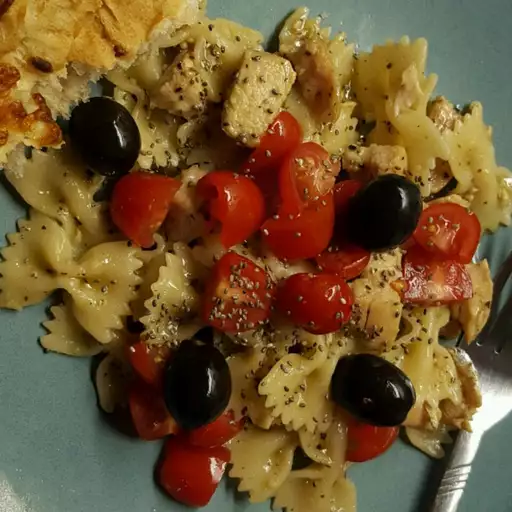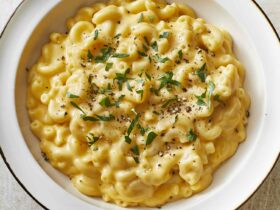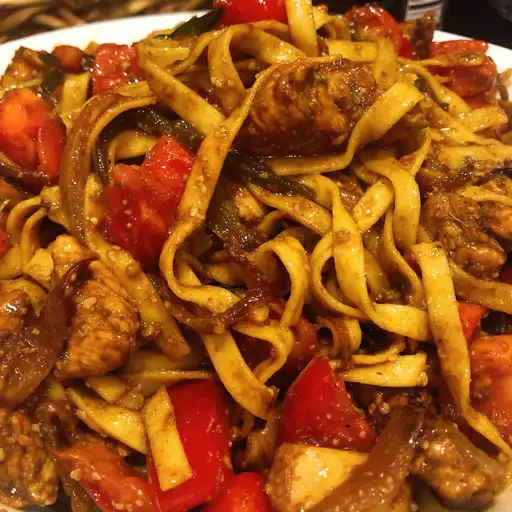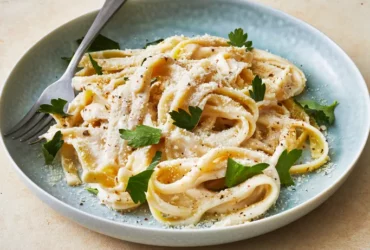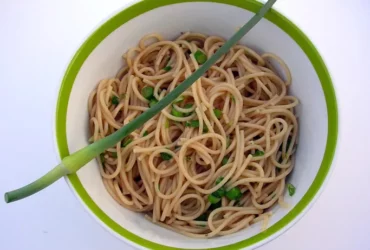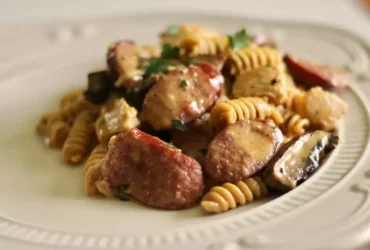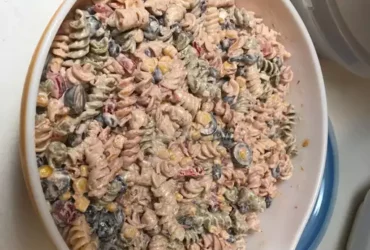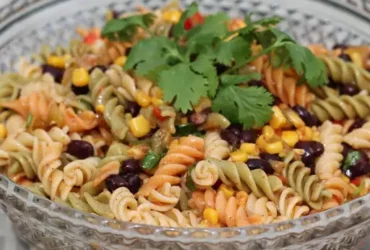Ingredients
For the chicken
The ingredients needed for this recipe can be broadly categorized into two groups: those required for the balsamic glaze, and those necessary for the chicken and pasta.
For the Balsamic Glaze:
- 1 cup of balsamic vinegar is a fundamental ingredient in creating the tangy and sweet flavor that coats the chicken. The acidity level of this type of vinegar adds depth to the dish.
- 1/4 cup of honey brings natural sweetness to the recipe, balancing out the sourness from the balsamic vinegar. This balance creates a harmonious flavor profile.
- 2 tablespoons of Dijon mustard provide an additional layer of tanginess and creaminess to the glaze, which complements the richness of the chicken.
- 1 teaspoon of dried thyme contributes a subtle herbal note that enhances the overall aromatic quality of the dish. Fresh or dried herbs can be used according to personal preference and availability.
For the Chicken:
- 2 pounds boneless, skinless chicken breasts are the centerpiece of this recipe. The lean protein content of chicken makes it an excellent choice for a healthy meal.
- 1/4 cup of olive oil serves as the base for the marinade, providing moisture and helping to prevent overcooking the chicken. Choose a high-quality extra-virgin olive oil for optimal flavor.
- 2 cloves of garlic are minced to add an aromatic punch to the dish. Garlic plays a crucial role in enhancing the overall flavor profile of many recipes.
- 1 teaspoon of salt and 1/4 teaspoon of black pepper are essential seasonings that bring out the natural flavors of the chicken. The ratio between salt and pepper should be balanced to avoid overpowering the other ingredients.
For the Pasta:
- 8 oz (225g) of penne pasta provides a satisfying base for the dish, with its tube-shaped design allowing sauces like balsamic glaze to cling to it. Choose a high-quality, whole-grain pasta option for added nutritional benefits.
- The quantities listed are suitable for four servings; feel free to adjust them according to your needs and preferences. This recipe offers flexibility in terms of ingredient proportions and cooking methods, making it adaptable to various tastes and dietary requirements.
The success of any dish largely depends on the quality and combination of its ingredients.
In this case, the balsamic chicken and pasta recipe requires the following key ingredients:
- Boneless, skinless chicken breast or thighs: Choose fresh and plump pieces of chicken to ensure tender and juicy results. You can also consider using pre-cooked chicken if you’re short on time.
- Pasta: Opt for a firm and smooth pasta shape such as penne, fusilli, or farfalle that will hold onto the balsamic sauce well.
- Extra virgin olive oil: This is the base of your dressing and provides a rich flavor to the dish. Choose a high-quality olive oil for the best results.
- Balsamic vinegar: Aged balsamic vinegar adds a tangy sweetness to the sauce. Use a good quality balsamic vinegar that’s been aged at least two years.
- Garlic and shallots: Finely chop or mince these aromatics for added depth of flavor in the dish.
- Rosemary: A sprig of fresh rosemary adds a fragrant herbaceous note to the balsamic sauce.
- Grated Parmesan cheese: A sprinkle of aged Parmesan enhances the flavors of the pasta and chicken.
Optional ingredients that can be added to enhance the flavor include:
- Fresh cherry tomatoes or grape tomatoes: Halve or quarter these for a burst of juicy sweetness in the dish.
- Caramelized onions: Slow-cooked caramelized onions add a deep and rich flavor to the balsamic sauce.
4 boneless, skinless chicken breasts
The ingredients for this Balsamic Chicken and Pasta Recipe are straightforward and focus on using high-quality components to bring out the best flavors. Among these essential items, 4 boneless, skinless chicken breasts stand out as a key ingredient.
Choosing the right chicken breasts is crucial in ensuring that they remain moist and tender throughout the cooking process. Boneless, skinless chicken breasts are ideal for this recipe because they offer several benefits:
Firstly, removing the bones allows for even cooking and prevents any bone fragments from getting stuck to the pasta or other ingredients.
Secondly, stripping away excess skin ensures that less fat is cooked into the dish, making it a healthier option without sacrificing flavor. Skinless chicken breasts are often leaner than their counterparts with the skin intact.
Lastly, boneless, skinless chicken breasts hold their shape well and can be easily sliced or cubed to suit the recipe’s requirements. This makes them versatile ingredients that fit seamlessly into various cooking methods.
In terms of specific characteristics, look for chicken breasts that are at least 90% lean protein content for optimal results. It is also essential to purchase fresh, high-quality chicken from reputable sources to ensure food safety and taste.
2 cloves of garlic, minced
When it comes to cooking up a delicious dish like Balsamic Chicken and Pasta, having the right ingredients is crucial. Among these essential components are two cloves of garlic, which play a significant role in elevating the flavor of your dish.
To use garlic effectively, it’s typically best to mince it first. Mincing involves cutting the garlic into very small pieces so that they can be easily distributed throughout the recipe and cook evenly. The process is relatively simple: peel the cloves, place them on a cutting board, and then finely chop them using a knife or a dedicated garlic press.
The end result of this effort should be a uniform mixture of tiny garlic particles with no visible whole pieces remaining. This minced state allows the potent flavors of the garlic to blend in harmony with other ingredients, adding depth and character to your dish without overpowering it.
Given its importance in cooking, garlic is an incredibly versatile ingredient that can enhance a wide range of recipes beyond Balsamic Chicken and Pasta. Its versatility stems from its unique ability to complement or contrast with almost any flavor profile, depending on how you choose to use it – whether as a key component like we’re using here or subtly added as an accent.
However, when working with garlic in specific contexts such as this recipe, knowing the optimal amount to include is vital for achieving the perfect balance of flavors. Too little garlic and the dish may lack oomph; too much, it could become overpowering. For Balsamic Chicken and Pasta, the two cloves recommended provide a standard starting point that can be adjusted according to personal taste preferences.
1 cup balsamic vinegar
The ingredients for this delightful Balsamic Chicken and Pasta Recipe are as follows:
- balsamic vinegar
- olive oil
- garlic cloves, minced
- dried basil
- dried oregano
- onion powder
- salt and pepper
- bay leaves (2-3)
- chicken breast, boneless and skinless (1 pound)
- grated Parmesan cheese (1/4 cup)
- pasta of your choice (12 ounces)
In this recipe, the star ingredient is indeed the balsamic vinegar. Specifically, we need 1 cup of it. For perspective, that’s equivalent to about 8 ounces or 250 milliliters. It’s essential to use high-quality balsamic vinegar that has been aged for at least 12 years to get that rich, tangy flavor.
1/4 cup olive oil
The balsamic chicken and pasta recipe calls for a variety of ingredients, with olive oil being one of the primary components. Olive oil is a type of edible oil extracted from olives, typically harvested in late summer or early fall.
When it comes to cooking with olive oil, quality matters. Look for an extra virgin or cold-pressed option that has not been adulterated with other oils. This will ensure the best flavor and nutritional profile for your dish.
In this recipe, 1/4 cup of olive oil is called for, which will likely be used in conjunction with aromatics such as garlic and onions to create a flavorful sauce. The acidity level of olive oil can also help balance out the sweetness of the balsamic glaze.
Some key characteristics of good-quality olive oil include:
- A strong, fruity aroma
- A rich, smooth texture
- A flavor profile that is neither bitter nor overly peppery
When choosing an olive oil for this recipe, consider a mild or medium-strength option to avoid overpowering the delicate flavors of the chicken and pasta. Some popular brands include:
- Colavita
- Maria’s Own
- Cucina Antica
In summary, olive oil is a versatile ingredient that plays a key role in the balsamic chicken and pasta recipe. By selecting high-quality olive oil and using it thoughtfully in your cooking, you can elevate the flavors and textures of this dish to create a truly memorable meal.
1 tsp dried thyme
A teaspoon of dried thyme is typically added to enhance the flavor of various dishes, including the Balsamic Chicken and Pasta recipe. It’s one of several ingredients used to season the chicken and add depth to the sauce.
Dried thyme is a type of herb that comes from the leaves of the Thymus vulgaris plant. The leaves are harvested when they’re still green but not yet fully mature, then dried and processed for use in cooking. This method helps preserve the herb’s flavor and aroma, making it easier to store and transport.
When using dried thyme in the Balsamic Chicken and Pasta recipe, it’s essential to understand that a little goes a long way. The strong flavor of this herb can overpower the other ingredients if too much is added, so it’s usually best to start with a small amount, such as 1 teaspoon, and adjust to taste.
The flavor profile of dried thyme is often described as earthy, minty, and slightly bitter. It pairs well with the sweetness of balsamic glaze and the acidity in tomatoes, making it an excellent addition to pasta sauces. In the context of the Balsamic Chicken and Pasta recipe, the thyme helps balance out the richness of the chicken and pasta, creating a more harmonious flavor experience.
The key to creating a delicious and authentic Italian dish like Balsamic Chicken and Pasta lies in the selection and combination of high-quality ingredients.
Balsamic vinegar, a staple in Italian cuisine, is made from reduced white wine and aged for a minimum of 12 years to achieve its characteristic thick and syrupy texture, rich flavor, and dark color. The aged vinegar is then strained through paper filters or left undisturbed in a barrel to settle the solids.
For this recipe, we recommend using high-quality, store-bought balsamic glaze, which can be easily found at most Italian markets or specialty food stores. However, if you’re looking for an authentic experience and want to make your own balsamic vinegar from scratch, be prepared to spend a significant amount of time and effort.
When it comes to the protein component, we suggest using chicken breasts as they are leaner, easier to cook evenly, and more versatile than other types of meat. Choose boneless, skinless chicken breast or tenderloin for this recipe, preferably with no added preservatives or artificial flavorings.
The pasta, a vital element in any Italian dish, should be made from durum wheat semolina, a coarse yellow powder obtained by grinding durum wheat into a fine flour. This type of pasta has a higher protein content than other types and holds its shape well when cooked al dente.
To add flavor and texture to the dish without overpowering the chicken or pasta, select some aromatics such as garlic, onion, shallot, and fresh herbs like parsley, basil, or thyme. For this recipe, we recommend using 3-4 garlic cloves, thinly sliced, and sautéed in olive oil until fragrant.
Fresh vegetables like cherry tomatoes, zucchini, bell peppers, and spinach add natural sweetness and color to the dish while providing a refreshing contrast to the rich flavors of the balsamic glaze and chicken. Use about 2-3 cups of sliced or diced vegetables for this recipe, depending on your preference.
Finally, don’t forget to season with salt and black pepper to enhance the overall flavor profile. Freshly ground black pepper adds a nice crunch while adding depth without overpowering the dish.
Instructions
Preparation
To prepare this delicious Balsamic Chicken and Pasta recipe, follow these detailed instructions carefully.
Preparation
The key to a successful dish lies in its preparation, so make sure you have all the necessary ingredients and tools ready before starting.
Ingredients
- Boneless chicken breasts (4)
- Pasta of your choice (e.g., penne, fusilli, or farfalle) (1 pound)
- Balsamic vinegar (2 tablespoons)
- Extra virgin olive oil (2 tablespoons)
- Minced garlic (2 cloves)
- Chopped fresh basil leaves
- Grated Parmesan cheese
- Salt and black pepper
Tools
- Cutting board
- Knife
- Colander
- Saucepan
- Skillet
- Wooden spoon or spatula
- Baking sheet (optional)
Instructions
- Precise the amount of chicken you are using to a precise measurement.
- Cut the boneless chicken breasts into thin slices or bite-sized pieces, depending on your preference.
- In a large bowl, whisk together balsamic vinegar and olive oil for at least three minutes until emulsified. Add minced garlic, salt, and black pepper, mixing well to combine.
- Add the sliced chicken to the marinade, making sure it’s fully coated. Cover the bowl with plastic wrap or a lid and refrigerate for at least two hours or overnight for better flavor.
- While the chicken is marinating, cook pasta according to package instructions until al dente. Drain and set aside in a large serving dish or separate containers.
- In a skillet or saucepan, heat about 1-2 tablespoons of olive oil over medium-high heat. Remove the chicken from the marinade, letting any excess liquid drip off (discard the remaining marinade). Add the chicken to the skillet and cook for about 5-7 minutes on each side, until it reaches your desired level of doneness.
- Transfer cooked pasta to individual plates or a large serving dish. Arrange the grilled chicken on top of the pasta.
- Sprinkle grated Parmesan cheese over the chicken and pasta, followed by chopped fresh basil leaves. Season with salt and black pepper to taste.
With these instructions and preparation steps, you’ll be able to create an authentic Balsamic Chicken and Pasta recipe that will impress your family and friends!
Instructions are crucial steps that guide individuals through a process to achieve a specific outcome. They provide clear and concise information on how to complete a task, ensuring that the desired result is obtained.
When it comes to cooking, instructions play a vital role in preparing a dish like Balsamic Chicken and Pasta. A recipe typically includes a set of step-by-step instructions that outline the preparation, cooking, and assembly of the ingredients.
The effectiveness of instructions depends on several factors, including clarity, specificity, and sequence. Clear instructions should be easy to understand, reducing confusion or ambiguity among individuals following them.
Specificity is also essential in instructions, as it ensures that all necessary details are included to complete a task accurately. For instance, in the context of Balsamic Chicken and Pasta Recipe, instructions might specify the exact type of pasta to use, the amount of balsamic glaze required, or the recommended cooking time.
The sequence of instructions is equally important. A well-structured recipe should follow a logical progression, starting with preparation, followed by cooking, and finally assembly. This order allows individuals to complete tasks in a timely manner and avoid confusion.
Instructions can be presented in various formats, including written text, images, videos, or a combination of these. In the case of Balsamic Chicken and Pasta Recipe, written instructions might include step-by-step descriptions, while accompanying images provide visual guidance on cooking techniques and ingredient presentation.
Additionally, instructions can be tailored to suit individual needs and preferences. For example, a recipe for Balsamic Chicken and Pasta might include variations or substitutions for individuals with dietary restrictions or allergies.
Ultimately, the purpose of instructions is to facilitate learning and ensure that desired outcomes are achieved. By following clear, specific, and well-structured instructions, individuals can master tasks like cooking, improving their skills and confidence in the process.
Cook pasta according to the package instructions, drain and set aside.
Cooking pasta is a crucial step in preparing the Balsamic Chicken and Pasta Recipe. To ensure that your pasta turns out perfectly cooked, it’s essential to follow the package instructions.
The first step is to bring a large pot of salted water to a bowl (rolling) boil. The amount of water needed will depend on the type and quantity of pasta you’re using.
Once the water is boiling, add the pasta and stir gently to prevent it from sticking together.
Cook the pasta for the recommended time specified on the package instructions, which can vary depending on the type of pasta. For example, spaghetti or angel hair typically cooks in 8-10 minutes, while thicker shapes like pappardelle may take longer.
While the pasta is cooking, prepare the other ingredients for your Balsamic Chicken and Pasta Recipe. This will help you stay on track and ensure that everything is ready to assemble when the pasta is done.
To check if the pasta is cooked, try biting into it. If it’s still hard or crunchy in the center, continue cooking for a few more minutes and checking again until it reaches your desired level of doneness.
Once the pasta is cooked, remove it from the heat and drain it thoroughly in a colander under cold running water. This will stop the cooking process and help prevent overcooking.
Finally, transfer the cooked pasta to a large serving bowl or individual plates and set aside for later use in your Balsamic Chicken and Pasta Recipe.
Season the chicken with salt and pepper to taste. In a small bowl, mix together garlic, thyme, balsamic vinegar and olive oil
To create a mouth-watering Balsamic Chicken and Pasta dish, follow these step-by-step instructions:
Prepare the chicken by seasoning it with salt and pepper to taste.
In a small bowl, combine the following ingredients to make the balsamic glaze:
- 2 cloves of garlic, minced
- 1 tablespoon fresh thyme leaves
- 2 tablespoons balsamic vinegar
- 2 tablespoons olive oil
Mix these ingredients together until well combined. The acidity in the balsamic vinegar will help to balance out the richness of the olive oil, while the garlic and thyme add depth and freshness to the dish.
Heat a large skillet over medium-high heat and sauté the chicken breast for 5-6 minutes per side, or until it reaches an internal temperature of 165°F (74°C).
Remove the chicken from the skillet and set it aside to rest. Leave any excess juices in the skillet.
Reduce the heat to medium and add the balsamic glaze to the skillet. Scrape up any browned bits from the bottom of the pan with a spatula, as these will add flavor to the sauce.
Simmer the balsamic glaze for 2-3 minutes, stirring occasionally, until it has thickened slightly and reduced by about half.
Add 8 oz (225g) of pasta of your choice (such as penne or linguine) to the skillet with the balsamic glaze. Toss the pasta in the sauce to coat.
Slice the cooked chicken breast and add it to the skillet with the pasta. Toss everything together until well combined.
Serve the Balsamic Chicken and Pasta hot, garnished with fresh thyme leaves if desired. Enjoy!
To prepare an excellent Balsamic Chicken and Pasta dish, it’s crucial to follow precise instructions to avoid any discrepancies in taste or presentation.
Here are some key steps to achieve a mouthwatering result:
- Select fresh ingredients: Fresh chicken breasts, pasta of choice (e.g., penne, linguine), cherry tomatoes, basil leaves, olive oil, balsamic vinegar, garlic powder, salt, and pepper.
- Cook the pasta according to package instructions. Generally, this involves boiling water in a large pot and then reducing heat once the water reaches a rolling boil. Cook until al dente (not mushy).
- Prepare the chicken by seasoning it with salt, pepper, and garlic powder on both sides. Place the seasoned chicken breasts on a baking sheet lined with parchment paper.
- Cook the chicken in the oven at 400°F (200°C) for about 20-25 minutes or until cooked through. The internal temperature should reach at least 165°F (74°C).
- While the pasta is cooking and the chicken in the oven, prepare the balsamic glaze by heating 1/4 cup of olive oil with 2 tablespoons of balsamic vinegar in a pan over medium heat. Stir occasionally until thickened slightly.
- Add sliced cherry tomatoes to the pasta once it’s done cooking and toss with basil leaves, salt, and pepper to taste.
- To assemble the dish, place cooked pasta on a plate or serving dish. Slice the grilled chicken and arrange on top of the pasta. Drizzle the balsamic glaze over both the chicken and pasta, followed by additional cherry tomatoes if desired.
By following these precise steps, you will be able to create a mouthwatering Balsamic Chicken and Pasta dish that showcases a perfect blend of flavors and textures.
Servings
Tips
Servings: This recipe typically serves 4-6 people, depending on serving sizes. If you’re looking to feed a larger crowd, you can easily double or triple the ingredients. Keep in mind that the cooking time may be slightly longer for larger quantities.
For this recipe, we recommend using boneless, skinless chicken breasts as they cook more evenly and quickly than bone-in chicken. You’ll want to cut the chicken into bite-sized pieces or strips before cooking to ensure even distribution throughout the pasta dish.
When it comes to the pasta, we suggest using a medium-width noodle such as penne, fusilli, or rotini. These shapes hold onto sauces well and provide a pleasant texture contrast to the tender chicken and tangy balsamic glaze.
To avoid overcooking the pasta, be sure to follow the package instructions for cooking time and al dente doneness. You can also cook the pasta according to your personal preference if you prefer it more or less firm.
For a flavorful and visually appealing presentation, consider garnishing with chopped fresh parsley, basil, or thyme. A sprinkle of parmesan cheese or shaved almonds can add texture and depth to the dish as well.
If you’re short on time or want to prepare this recipe ahead of time, consider cooking the chicken and pasta separately and then assembling the dish just before serving. This way, the flavors can meld together without losing their vibrancy and intensity.
Lastly, don’t be shy with the balsamic glaze – it’s the star of the show in this recipe! Use it liberally to drizzle over the chicken, pasta, and vegetables for a rich, velvety flavor that’ll leave your taste buds singing.
In the context of the Balsamic Chicken and Pasta Recipe, servings refer to the number of people that this dish can satisfy or feed. It is an essential piece of information for individuals planning to prepare and serve this meal for a specific group of people.
Servings are usually expressed in terms of the quantity of food required per serving, such as grams, ounces, or cups. For instance, in the Balsamic Chicken and Pasta Recipe, a serving might be defined as a portion that contains a certain amount of chicken, pasta, sauce, and vegetables.
When it comes to determining servings for this recipe, several factors come into play, including the size of the portions, individual appetites, and nutritional needs. For example, if you are planning to serve a group with larger appetites or children, you may need to multiply the number of servings to ensure everyone gets enough food.
Servings can also be influenced by the ingredients used in the recipe. In the Balsamic Chicken and Pasta Recipe, the amount of chicken breasts, pasta, and vegetables will impact the overall serving size and number of people that can be fed. For instance, if you are using smaller chicken breasts or less pasta than recommended, you may end up with fewer servings.
It’s worth noting that the yield per recipe is often expressed in terms of servings per batch or total servings for a specific quantity of ingredients. This information helps home cooks and professionals alike to adjust ingredient quantities according to their needs and ensure that everyone gets a fair share.
In conclusion, when it comes to planning and preparing meals like the Balsamic Chicken and Pasta Recipe, understanding and calculating servings is crucial to ensure that everyone has enough food and enjoys a satisfying meal. By considering individual appetites, nutritional needs, ingredient quantities, and serving sizes, you can confidently prepare delicious meals for your loved ones or clients.
Traditionally, Balsamic glaze is used on top of the dish as a finishing touch, it adds depth and flavor to the pasta and chicken. To make balsamic glaze reduce 2 cups of balsamic vinegar over low heat until thickened.
In traditional Italian cuisine, balsamic glaze serves as a versatile condiment that elevates the flavors of various dishes, including pasta and chicken.
The recommended serving method for balsamic glaze is to drizzle it on top of the dish as a finishing touch, thereby adding depth and flavor to the overall culinary experience.
The preparation of balsamic glaze involves reducing 2 cups of balsamic vinegar over low heat until the liquid has thickened, creating a rich and syrupy consistency.
This process allows the natural flavors of the balsamic vinegar to intensify, resulting in a concentrated and complex sauce that can be used to enhance the flavors of various ingredients, including pasta and chicken.
When served with balsamic glaze, the pasta and chicken dish is transformed into a harmonious balance of flavors, textures, and presentation, making it a truly satisfying and enjoyable meal.
Servings refer to the quantity of food or dishes that are intended to be served at one time.
In the context of a recipe, servings provide an estimate of how many people can be fed with the ingredients and instructions provided.
The number of servings in the Balsamic Chicken and Pasta Recipe would depend on serving sizes, which vary depending on individual appetites and preferences.
Typically, one serving size for pasta is about 1 cup cooked or a portion that is equivalent to 1/6 of a standard 12-inch plate.
A more specific guide is as follows:
- For women, one serving is often considered 3 ounces (85g) of protein and 1/2 cup of carbohydrates such as pasta. For example, a chicken breast or a serving of vegetables could be the source of the protein, while rice, bread, or pasta would constitute the carbohydrate portion.
- For men, one serving might be considered about 4 ounces (115g) of protein and 3/4 cup of carbohydrates.
- In terms of specific numbers for the Balsamic Chicken and Pasta Recipe, it is common to assume that four servings could be produced from the ingredients listed in a standard recipe, assuming each person consumes approximately 1/6 of a plate (the standard portion size).
- However, these are only general guidelines. Serving sizes may vary depending on individual appetites or specific needs, and additional factors such as accompaniments and side dishes also influence how much food is considered a full meal.
Health considerations
The serving size for Balsamic Chicken and Pasta Recipe can vary depending on individual appetites and needs. A standard serving size for this dish could be approximately 1/4 to 1/2 cup of cooked pasta per person, accompanied by a piece or two of grilled chicken, and topped with balsamic glaze or reduction.
However, the specific serving sizes may change based on factors such as age, sex, and physical activity levels. For example:
- Children (ages 4-8): 1/4 cup of cooked pasta, 1 oz or 28g of grilled chicken.
- Children (ages 9-12): 3/4 cup of cooked pasta, 2 oz or 57g of grilled chicken.
- Adults: 1/2 to 3/4 cup of cooked pasta, 3 oz or 85g of grilled chicken.
When it comes to health considerations, this Balsamic Chicken and Pasta Recipe offers a balanced mix of protein, complex carbohydrates, and fiber-rich vegetables. However, as with any meal, certain factors should be kept in mind:
Allergies: Some ingredients in the recipe may trigger allergies or intolerances, such as gluten from the pasta or soy sauce used in the balsamic glaze.
Dietary restrictions: Vegetarians and vegans should not consume the chicken component of this dish. Gluten-free options can be used for those with gluten intolerance or sensitivity.
Nutritional values: This meal is relatively high in calories due to the pasta and olive oil. To balance out the dish, consider adding more vegetables like cherry tomatoes, spinach, or sliced bell peppers. A moderate amount of red wine vinegar or balsamic glaze can provide a tangy flavor without adding extra calories.
Sodium levels: As this recipe involves salted chicken broth and soy sauce, be mindful of the overall sodium content in your meal. Consider reducing the amount of soy sauce used or opting for low-sodium alternatives.
By being aware of these considerations and making adjustments to suit individual needs, you can enjoy a healthier and more balanced version of this delicious Balsamic Chicken and Pasta Recipe.
In this Balsamic Chicken and Pasta recipe, one key element to consider when planning servings is the number of people it will feed.
A standard serving size for pasta is typically 1/2 cup cooked per person for a main course or 1/4 cup for an appetizer or side dish. In this recipe, the pasta yield is about 6-8 cups, which translates to 12-16 servings depending on the serving size.
For the chicken, a standard serving size is around 3 ounces or the equivalent of a single boneless breast half. With 2 pounds of chicken breasts in this recipe, you can estimate 4-5 servings per pound, making it about 8-10 servings total.
When calculating overall servings for your Balsamic Chicken and Pasta Recipe, you should consider both the pasta and chicken yields to determine how many meals or portions you will have.
In a family setting with moderate appetites, you might aim to serve around 6-8 people. However, if some guests are particularly hungry or there’s a large age gap with varying appetites, adjust your servings accordingly. You can always save leftovers for later meals by refrigerating them overnight and reheating as needed.
To maximize the number of servings without sacrificing flavor or texture, consider using the full 2 pounds of chicken and adjusting pasta portion sizes slightly smaller than standard, if necessary. This will ensure you have enough protein-rich chicken to go around while still satisfying everyone’s hunger.
The American Heart Association recommends reducing sodium intake to help lower blood pressure and risk of heart disease, this recipe uses minimal amounts of salt.
This Balsamic Chicken and Pasta Recipe is designed to provide a delicious and heart-healthy meal option for those looking to reduce their sodium intake. As recommended by the American Heart Association, limiting sodium consumption can help lower blood pressure and decrease the risk of heart disease.
The recipe uses minimal amounts of salt, making it an ideal choice for individuals who are trying to reduce their sodium intake. To further minimize sodium content, we suggest using low-sodium chicken broth or a homemade alternative made with vegetables and herbs. This substitution will not only reduce sodium levels but also add extra flavor to the dish.
The combination of balsamic glaze and fresh basil in this recipe provides a tangy and savory flavor profile that doesn’t require excessive salt to taste good. The sweetness of the balsamic glaze balances out the acidity, creating a harmonious flavor experience that will leave you wanting more. By using high-quality ingredients like fresh pasta and balsamic vinegar, we can create a dish that is not only delicious but also healthy.
To further enhance the health benefits of this recipe, consider using whole wheat or whole grain pasta instead of regular white pasta. This simple substitution can increase the fiber content of the dish, which can help lower cholesterol levels and improve overall digestive health.
The serving suggestions for this Balsamic Chicken and Pasta Recipe are versatile and accommodating to various dietary needs. Feel free to serve with a side salad or steamed vegetables for a more balanced meal. You can also offer a variety of protein options, such as grilled chicken, shrimp, or tofu, to cater to different tastes and preferences.
When serving this recipe to a crowd, consider preparing the ingredients in advance to make assembly easier. Cook the pasta and chicken according to the instructions, then assemble the dish by combining the cooked pasta, chicken, and balsamic glaze in individual servings or a large family-style platter. This will allow everyone to enjoy a delicious and satisfying meal while also promoting heart-healthy eating habits.
This recipe serves 4-6 people, making it an excellent choice for a family dinner or a gathering with friends.
The serving size can be adjusted to accommodate smaller or larger groups by scaling up or down accordingly.
Servings Breakdown
Here’s how the ingredients and prepared dishes break down per serving:
- Balsamic Chicken: 1 breast, sliced into strips (approximately 3 oz or 85g per serving)
- Pasta: 1 cup cooked (about 8 oz or 225g per serving)
- Vegetables: 1/2 cup cherry tomatoes, halved; 1/4 cup sliced red onion
- Herbs: Fresh basil leaves for garnish
The calorie count per serving is approximately:
- Total Calories: 420-500 calories per serving
- Macronutrient Breakdown: 35g protein, 40g carbohydrates, 20g fat per serving
This recipe offers a balanced and satisfying meal option for individuals with moderate dietary needs.
- Best Datanyze Alternatives for 2025 - April 24, 2025
- Best Hunter.io Alternatives for 2025 - April 22, 2025
- Best Lead411 Alternatives for 2025 - April 22, 2025

